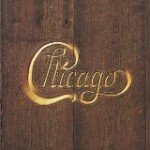Thirty-seven years ago hard-core Chicago fans like me thought the rest of the county had finally caught on. In retrospect, what we were seeing was actually the beginning of a new and different path, one that would lead some of us from the band.
 On August 19, 1972, Chicago V became the number one album in the U.S., the first album by the band to reach that mark. But even from the outset, fans should have noticed a change.
On August 19, 1972, Chicago V became the number one album in the U.S., the first album by the band to reach that mark. But even from the outset, fans should have noticed a change.
The first clue might seem a bit odd but it was the fact the album consisted of only one LP. The first three Chicago releases had been two-LP sets while the fourth was a massive four-LP live album. Yet that difference actually shows up in the music. Unlike the first three albums, Chicago V doesn’t have extended expositions where the band explored tunes in greater detail. Instead, the longest tune (although listed as two on the LP) was “Dialogue, Part I and Part II.” At just over seven minutes (it was cut to about five for radio play), it was built on a conversation between guitarist Terry Kath as a politically conscious individual and bassist Peter Cetera as a college student more interested in getting high than politics.
But a number of the tunes on the LP seemed more pop oriented, a reflection in part of keyboard player Bobby Lamm taking on more of the songwriting duties. He wrote 80 percent of the tunes on the album, including the hit “Saturday in the Park.” This more poppish trend would continue on Chicago VI, another single LP that would reach number one and that seemed to have pop and radio written all over it. By about 1975, the music I identified as Chicago seemed to have been swallowed up.
Don’t get me wrong. Parts of Chicago V that are tremendous. The opening cut, also written by Lamm, was a tribute to composer Edgar Varèse called, appropriately “A Hit by Varèse.” Built around an unusual meter like seen in Varèse’s compositions, it also features the horn section trading several rounds of jazz-inspired solos. There is the political and social commentary of not only “Dialogue” but “While the City Sleeps” and “State of the Union” (which Cetera has said is based on an incident that occurred in Sioux Falls). It closes with a bluesy acoustic piece written by Kath that seems to be a look back at the history of the band and perhaps even the closing of the Sixties.
But it seems that so much of the power is watered down by a more pop-oriented feel. A perfect example is “Dialogue Part 2.” Kath has an excellent solo but it seems buried and lost in the mix. There are other times you wish someone in the band would take off on an extended solo but it just doesn’t happen. Yet it was really only with the perspective of the later albums that we can see this release was the first harbinger of a change in style and direction.
Of course, there’s also the fact that maybe I’m just showing my age. After all, Kath was the heart and soul of the band I loved. A founder of the band, he died in 1978, 11 years after Chicago was formed. Earlier this week, latecomer Bill Champlin announced he was leaving the band — after 28 years.
Will you try to change things
Use the power that you have
The power of a million new ideas?
“Dialogue, Part I,” Chicago V







